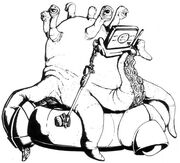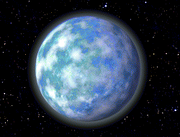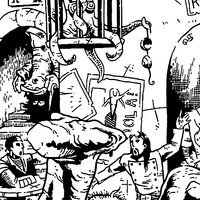Warning: This infobox has missing parameters: subspecies, mass and unrecognized parameters: members, imageBG
- "How dare you speak to me like that! You don't even have a fifth tentacle!"
- ―An Iyra
The Iyra were a species of sentient cephalopods from the watery planet F'tral. Each Iyra had four or more limbs that spread from the radially symmetrical body, an arrangement that made each member of the species one to two meters in diameter. The mouth opened from the ventral side of the body, and one eyestalk grew for each tentacle. As an Iyra became older, he or she grew more tentacles and eyes. The species' leathery skin was elastic and capable of changing color for camouflage or for courtship rituals. Although they were aquatic and resided in large undersea cities, Iyra were able to survive on land. They were clumsy out of water, however, and preferred to travel on small repulsor sleds known as floating ponds.
Iyra society was governed by a rigid caste system that placed Iyra with more tentacles—the older and larger members of the group—at a higher position. Iyra careless enough to lose a tentacle through accident or in combat suffered a reduction in caste and had to destroy an eye to correspond to the lost limb. Disputes between Iyra of equal caste were sometimes settled via duels. The first to lose a tentacle was immediately reduced to a lower caste and forced to yield to the superior combatant. The lowest caste, composed of four-armed Iyra, was responsible for raising the young. Iyra tended to view members of other species through the lens of the caste system; Iyra with five or more tentacles thus looked down upon humanoids and other two-armed bipeds. The Iyra's attitude lent them a reputation as arrogant among other species.
Since Iyra could absorb oxygen through their skin, Iyra starships were filled with gaseous atmosphere heavy in water vapor. The strategy contrasted that of many purely aquatic species whose attempts to design craft filled with liquid water made them both heavier and more expensive to operate. Iyra were leaders in the manufacture of corrosion-resistant metal alloys and the design of gravity-manipulation equipment and inertial devices for starships. Famous Iyra included Tem Eliss, the eminent sentientologist who wrote The University of Sanbra Guide to Intelligent Life.
Biology and appearance

Iyra had at least four tentacles. Tem Eliss, the Iyra sentientologist, used his to manipulate writing implements.
The Iyra were sentient cephalopods whose round bodies featured multiple tentacles that radiated from a plump central section with a gaping, grinding maw at its underside. The body was covered in rubbery skin, the color of which the Iyra could change to help blend into the environment and to facilitate communication.[1] An Iyra's skin needed not be all one hue; complex patterns such as stripes were within the individual's control.[4] The skin acted as a respiratory organ, functional in both air and water,[1] provided it was kept moist.[4] Iyra were comfortable at great depths, able to ignore the detrimental effects of water pressure suffered by many other species.[5]
Barring accidental maiming or amputation, Iyra had at least four tentacles:[1] flexible, elongated body structures that had a mostly conical shape but flattened out toward their undersides. Two rows of suction cups lined the bottom of each limb,[4] allowing the appendages to serve as fine manipulators. Each tentacle was paired with an eyestalk,[1] a short, thin growth at the top of the protuberant body section that housed an oblong visual organ, with a sclera and pupil, protected by heavy lids.[6] The eyestalks swiveled to allow an Iyra to concentrate several eyes in a certain direction,[7] and the visual organs granted the cephalopods excellent underwater vision. From tentacle-tip to tentacle-tip, Iyra ranged from one[1] to two meters in diameter.[5]
Internally, Iyra biology followed patterns unlike those of many other sentient species.[8] Most internal organs were housed within the central body that contained the digestive tract, lungs, a sizable brain,[2][1] and multiple hearts.[9] The species lacked any internal skeletal system,[4] so most of their mass was pure muscle.[5] Nevertheless, a brainpan protected the brain.[7] Their flexible body structure allowed Iyra to contract and squeeze their bodies[1] and played a role in locomotion; underwater, Iyra could achieve great swimming speed[5] by contracting muscles and expelling water from the mouth. On land, however, they were limited to laboriously slapping an outstretched limb onto the ground and then dragging the rest of the body forward to meet it.[1] Similarly, Iyra suffered reductions to their motor skills when in an atmosphere.[5] The Iyra were endothermic organisms with the ability to withstand the chilling waters of their underwater domain.[1]
Iyra had two sexes and reproduced sexually, with the male inserting a specialized mating tentacle into the female and fertilizing the clutch of eggs inside her body. The eggs gestated and hatched internally, at which point the mother expelled the live young. Iyra children were born with four tentacles and four eyestalks, with new limb–eye pairs continually growing throughout the individual's lifespan.[1]
Society and culture
To outsiders, Iyra generally seemed to possess great wisdom—matched by even greater egos.[2] The cephalopods often came off as haughty blowhards[1] who took offense to any perceived slight and rarely refrained from unleashing barbs of their own.[5] Part of this penchant for superciliousness arose from the Iyra's caste system, which determined an individual's status based on his or her number of limbs. Thus, four-limbed creatures like humanoid species fell into the lowest rung of the Iyra reckoning of status by default.[1] Species with five or more limbs tended to be treated better by the aquatic beings.[10] Still, Iyra tended to prefer the company of their own species to that of non-Iyra.[11]
To the Iyra, class and status were of the utmost importance. Due to the association of status with tentacle number, the relative social positions of two individuals were readily apparent upon any encounter:[1] the Iyra with fewer tentacles deferred to his or her superior without question.[4] Rather than view this system as repressive, however, most Iyra believed that because members of their species continued to grow new limbs throughout their lives, all Iyra could expect to experience great social mobility. Further, the more status—and tentacles—an Iyra had, the older he or she was likely to be, a system that ensured that the oldest and wisest individuals assumed positions of leadership in a community.[1] Nevertheless, some younger Iyra did express resentment of their elders in ways similar to the adolescents and youths of many other species.[12]

Iyranis Gravitics Limited, an Iyra company, produced the Iyra gravity belt.
Iyra were prone to rows within the same caste, which called for a two-stage system of mediation. First, the Iyra were expected to discuss their grievances and talk out a solution. If such peaceful methods failed, Iyra custom called for a duel,[4] a task for which the species' multiple limbs made them quite adept.[5] Such brawls were fought not to the death but rather to the loss of a tentacle, an outcome that automatically reduced the loser's status and forced him or her to defer to the opponent.[4] Even if the result of an accident, losing a tentacle reduced the Iyra's status to that of the caste with the same number of manipulators. Iyra rationalized this relegation by holding that anyone who lost a limb obviously lacked the sagacity needed to justify having the limb in the first place. Iyra custom forced anyone who lost a limb to sacrifice the corresponding eyestalk as well. In cases where a member of the species lost only an eyestalk, however, retained the status indicated by their number of tentacles, but they lost their authority over the caste directly subordinate to them.[4]
Iyra mated twice each year at specialized breeding grounds on their homeworld. Copulation first required intricate courtship behavior wherein the males put on shows of virtuoso skin-color changing accompanied by an aquatic dance. Each female responded to her favorite mating display and embraced her chosen paramour to reproduce. Once born, Iyra young were placed under the charge of the four-tentacled caste.[10]
The Iyra had access to technology on par with most of the rest of the galaxy. They inhabited large, underwater cities on the ocean floor, where they used geothermal energy to extract metals from ore.[4] The species was particularly famed for the alloys they produced, which were resistant to corrosion. Iyra engineers also excelled at hydraulics-, magnetism-, and fusion-based technologies. Another area of Iyra innovation was in hyperdrive-equipped spacecraft designed for aquatic beings. Rather than trying to fill their ships with water as many other aquatic species had attempted, the Iyra realized that this added mass was a serious liability in achieving efficient flight. Instead, they created a system whereby Iyra ships were filled with an atmosphere thick with water vapor. The mixture kept the Iyra crewmembers moist,[4] protected their internal chemical homeostasis,[13] and allowed them to breath properly while in space. Other Iyra areas of expertise were in gravitational acceleration and compensation for inertial disturbances. The Iyra were vigorous traders who sold technological products to offworlders in exchange for other goods.[4] One Iyra-owned corporation was Iyranis Gravitics Limited, which produced gravity-manipulating technology.[14] One of their items was the Iyra gravity belt, a wearable garment that looked like a normal utility belt but which used gravity fields to guide a person in freefall.[15] At least some Iyra were known to drink a salty beverage known as brinebrew.[16]
The Iyra's native language had both a spoken and written form. The script used for the tongue incorporated various squiggles and curved shapes.[3] The name of the species' homeworld, F'tral, meant "water" in the language.[2] At least one Iyra had two names, the sentientologist Tem Eliss.[3] Members of the species were capable of learning to speak Basic.[16]
History

The Iyra evolved on the water world of F'tral.
The Iyra evolved on F'tral, a largely aquatic world with 93 percent of its surface submerged. The presence of carnivorous plant life on the planet's scattered landmasses made life on land precarious and depressed the evolutionary development of terrestrial animals. Instead, aquatic species evolved[1]—including crustaceans ancestral to the Iyra[17]—and cephalopods rose to dominate those parts of the planet that lay beneath the waves. From this stock came the Iyra, who paired their ancestors' multiple suckered tentacles with larger brains and bodies. Increased intelligence allowed the Iyra to reach the pinnacle of F'tral's lifeforms.[1]
Large brains permitted the Iyra to make and use tools and to form advanced societies that adhered to what became the standard tentacle-based caste system.[1] After F'tral received its first visitors from another world, the Iyra were introduced to the galactic community—a community dominated by land-dwelling species. In order to better integrate and join their comrades among the stars, Iyra scientists developed specialized equipment designed specifically for the tentacled beings,[5] and special craft that saturated the interior with water vapor, keeping the skin moist.[4] Their planet eventually became part of the Calaron sector in the Outer Rim Territories,[18] a part of the galaxy considered part of the Slice.[19] By 52 BBY, F'tral had fallen within the confines of Hutt Space,[20] a situation that persisted at least through the Clone Wars.[21] By 14 BBY, the borders of Hutt Space had retracted to no longer encompass the Iyra home system.[22] During the Galactic Civil War, the sentientologist Obo Rin, working for the Galactic Empire, described the Iyra in the Catalog of Intelligent Life in the Galaxy. The work was ostensibly a collection of information on those species Rin felt most important in the galaxy and of the most interest to Emperor Palpatine.[17][23] Years later, in 137 ABY, F'tral fell within a region known as the Hutt dependencies.[24]
Iyra in the galaxy
- "In light of the goals of this manuscript, I have been required to honestly state facts, regardless of their political implications. Rather than mindlessly reiterate the views held dear by certain factions within the Imperial bureaucracy (particularly COMPNOR's Coalition for Progress, Art Group), I have chosen to honestly discuss issues, regardless of how those passages might be viewed by imperial officials."
- ―Tem Eliss

An Iyra caught in a cage in Shilley's cantina on Questal
Iyra were widespread in the galaxy at large, although they faced discrimination from members of other species due to their personalities, which came off as abrasive to non-Iyra. The cephalopods strongly preferred water worlds, with low- or zero-gravity environments their second choice; terrestrial worlds with standard gravity were a distant third. In non-aquatic environments, Iyra often made use of floating ponds, each of which looked like a bowl of water that hovered on a repulsorsled;[4] at rest, Iyra could lounge in aquachairs.[16] Many Iyra expatriates operated as traders. Although these merchants traveled to a variety of worlds, they preferred those with marine docking facilities.[4] Other Iyra found work as starshipwrights. The water planet Krinemonen III was home to Iyra shipbuilders, who worked alongside Mon Calamari, Priapulin, and Quarren counterparts.[25] At some point during the Galactic Civil War, an Iyra was in a cage at Shilley's, a cantina on the planet Questal.[26]
Tem Eliss was an Iyra academic who became famous—or infamous—during the Galactic Civil War as a sentientologist with a strong anti-Imperial slant. Although born on F'tral, Eliss grew up traveling the spacelanes, so he failed to pick up his species' intolerant attitude toward other species and many of the other character traits non-Iyra often found so objectionable. His attitude earned him the disdain of his fellow Iyra, but it won him respect and friendship from his academic peers.[11] Eliss wrote about non-Human species even as an undergraduate,[27] and he eventually worked his way up to become the head of the Sentient Studies Department at the University of Sanbra.[11] Eliss spent much of his career researching and writing The University of Sanbra Guide to Intelligent Life, a catalog that detailed the biology, society and culture, history, and inter-species relations of various sentient species. Eliss completed the first volume of the work during the Galactic Civil War, a process during which he refused to censor the document to conform to the expectations or the University of Sanbra's generally pro-Human and pro-Imperial factions. Informants within his department reported Eliss and the work to the Empire's Commission for the Preservation of the New Order and advocated that the Empire arrest the Iyra. Eliss learned of the betrayal and fled the university and the De'etta system.[28] He took refuge on the planet Krinemonen III, where his cousin Tam resided;[25] rumors said that the scientist had gone into hiding with the Alliance to Restore the Republic. Despite the attempts to silence Eliss, The University of Sanbra Guide to Intelligent Life soon appeared on student communication nets and achieved wide distribution.[28] From exile, Eliss continued to update the Guide.[6] After the fall of the Empire and the rise of the New Republic, the academic came out of hiding and was restored to his position at the University of Sanbra. He was still active well into the Yuuzhan Vong War.[29]
Behind the scenes
The Iyra first appeared in Galaxy Guide 4: Alien Races, a book written by Troy Denning and published as part of the Star Wars: The Roleplaying Game line from West End Games in 1989. The entry for the species includes game statistics to allow players to portray Iyra characters; according to these rules, Iyra are slightly more adept than Humans at intelligence-based and technical tasks.[2] The species' write-up was revised slightly by Chuck Truett for the second edition of the book, published in 1994. In this volume, the Iyra are presented as slightly deficient in piloting aptitude and perception, but otherwise on par with Humans and other species. The book suggests that their role in adventures should mostly be as comic relief.[30]
The West End adventure book Classic Adventures: Volume Five, published in 1998, includes a reprint of the adventure The Game Chambers of Questal with new art drawn by Andrew Bates and Ramón Pérez. One illustration depicts an Iyra in a cage, an illustration that did not appear in the original version of the adventure.[26]
Appearances
 "An Extinct Guest" — Star Wars Adventure Journal 14 (First appearance)
"An Extinct Guest" — Star Wars Adventure Journal 14 (First appearance)- Star Wars: Rebellion (Mentioned only)
- The Game Chambers of Questal
 "The Game Chambers of Questal'" — Classic Adventures: Volume Five
"The Game Chambers of Questal'" — Classic Adventures: Volume Five
Sources
- Galaxy Guide 4: Alien Races (First mentioned)
- Star Wars: The Roleplaying Game, Second Edition
- Galaxy Guide 4: Alien Races, Second Edition
- Creatures of the Galaxy
- Galladinium's Fantastic Technology
- Galaxy Guide 12: Aliens — Enemies and Allies
 "Alien Encounters" — Star Wars Adventure Journal 14
"Alien Encounters" — Star Wars Adventure Journal 14- Star Wars Encyclopedia
 "The University of Sanbra Guide to Intelligent Life: The Marvel Series" — Star Wars Gamer 1
"The University of Sanbra Guide to Intelligent Life: The Marvel Series" — Star Wars Gamer 1 "The University of Sanbra Guide to Intelligent Life: The Jawas" — Star Wars Gamer 3
"The University of Sanbra Guide to Intelligent Life: The Jawas" — Star Wars Gamer 3 "The University of Sanbra Guide to Intelligent Life: The Priapulin" — Star Wars Gamer 8
"The University of Sanbra Guide to Intelligent Life: The Priapulin" — Star Wars Gamer 8- The Complete Star Wars Encyclopedia
